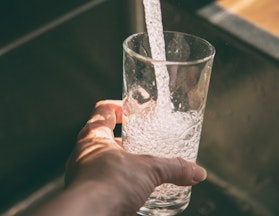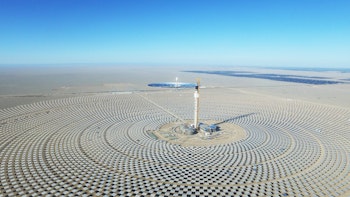
The global desalination market appears is on a roll. One report predicts a compound annual growth rate of 7.7%, equal to a yearly investment in desalination of USD$27 billion by 2025. A range of factors is driving this growth.
On the demand side, readily available fresh water is becoming scarcer. Shortages are a reality for a staggering 4 billion people, for at least one month a year. Meanwhile water use is rising quickly.
Total freshwater demand, for all uses, is currently around 4,600 cubic kilometers each year. This is predicted to increase 20% to 30% by 2050, up to between 5,500 and 6,000 cubic kilometers per year.
Decreasing prices
On the supply side, meanwhile, the costs for building desalination plants and running them are falling. Meanwhile, the integration of concentrated solar power into desalination plants can help to reduce energy costs. Specifically, the factors bringing costs down are:
- An increase in quality and decrease in costs for membranes used in reverse osmosis.
- The rise of efficient build-own-operate-transfer project delivery methods.
- The co-location of desalination plants with power generation assets.
- Economies of scale resulting from larger-capacity plants.
Globally, more than 300 million people already get their drinking water thanks to desalination. But where are the key areas for growth? A brief survey of current deployments provides some clues to where desalination is set to expand.
Middle East and North Africa
The Middle East and North Africa region boasts 4,826 desalination plants, producing 45 million cubic meters of water a day, or just under half of the current global production. Saudi Arabia relies particularly heavily on desalination.
Located in an arid part of the Middle East and with access to cheap sources of energy, around 20% of the kingdom’s water is produced through desalination of seawater.
The kingdom is home to some of the largest desalination plants of the planet, including the biggest, Ras Al Khair, which produces over a million square meters of water per day.
The country has clearly seen the value of desalination and has several further large plants on order or under construction.
The Middle East and North Africa region boasts 4,826 desalination plants, producing 45 million cubic meters of water a day
Although the plant employs some membrane separation (reverse osmosis), this is not the norm in Saudi Arabia and the wider region, which has an older installed base of desalination plants relying on thermal technique to produce useable drinking water.
Israel and Australia
In contrast, Israel’s installed base predominantly utilizes reverse osmosis, the dominant technology outside the Middle East and North Africa. Now a major user of desalination, the country ramped up its efforts after a long and debilitating drought.
Plants at Itsin Sorek, Ashkelon, Ashdod, Palmachim and Hadera now produce 80% of the country’s water for domestic use, and more are planned.
One of these, the Sorek B utility, will be the world’s largest desalination plant with a capacity of 200 million cubic meters of water per year, once completed.
Even now, the country already has more drinking water than it needs, but its hoped that even greater capacity will allow it to sell water to its parched neighbors and engage in ‘water diplomacy.’
A long drought was also a key factor in spurring Australia to invest heavily in desalination plants. And like in Israel, investments in Australian desalination plants have largely been city-based initiatives, reflecting the intensive use of water in metropolitan areas.
A case in point is Melbourne, which began constructing its plant in 2017 at a cost of USD$4.5 billion after experiencing lower than average rainfall for 18 out of the previous 20 years. Perth, Sydney and Adelaide are amongst other Australian cities served by major desalination plants.
United States
The twin factors of preexisting water scarcity and decreasing precipitation as a result of climate change have been key in encouraging the growth of desalination in Southern California.
Like Arizona, the region has water table challenges, and the snows that feed the strategic Colorado river are waning year on year. Meanwhile Texas now has 49 municipally-owned plants that specialize in desalinating brackish water, rather than seawater.
Texan city San Antonio is currently building a large desalination plant to extend this activity. Elsewhere, it remains to be seen how other states may need to invest in plants as a result of trends such as climate change and groundwater overuse.
Europe
In Europe, desalination activities are dominated by Spain. This is hardly surprising, given it includes some of the driest regions in Europe, with as little as 200 millimeters of rainfall per year in the country’s southeast. Spain’s Mediterranean coast already suffers from water shortages.
Nearly all surface water is already stored in reservoirs, so building more is a waste of resources at this point. Spain has been at the forefront of reutilizing water in Europe, so further desalination efforts seem likely.
With Europe as a whole experiencing drought at an increasing rate since the mid-1970s, it appears that desalination will have an increasing role to play across the continent, particularly along its Mediterranean coast.
CSP could be key
Needless to say, most desalination plants are on or near the coast. Conveniently, around half of the world’s population lives in metropolitan areas bordering the ocean. It’s also no surprise that the majority of the areas with the greatest need for desalination are also the sunniest.

This makes it interesting to drive power-hungry desalination plants through solar energy. Concentrated solar power (CSP), in particular, can help drive down the costs of desalination by providing round-the-clock electricity from the sun.
In 2018, the US Department of Energy announced a $21 million investment into 14 new solar thermal desalination projects.
This initiative is hoping to produce a levelized cost of water (LCOW) of $0.50 per cubic meter for larger facilities that process high volumes for a municipal utility. This compares very favorably with the process for recycled water, which has a LCOW of roughly a dollar per cubic meter.
The use of CSP not only helps bring down the energy costs for desalination, but also makes desalination available for more remote areas, allowing the industry to go beyond the large population centers it currently now serves. Pacific Green can offer more information on this.
Publish date: 24 June, 2020